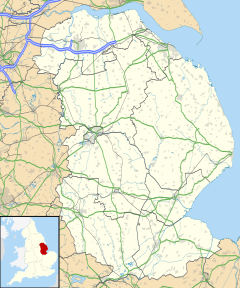Aslackby and Laughton is a civil parish[1] in the South Kesteven district of Lincolnshire, England. According to the 2001 census the parish had a population of 243,[1] in 102 households.[2] increasing slightly to 251 in 118 households at the 2011 census.[3] It consists of the village of Aslackby, the hamlet of Laughton, and scattered farms,[4] and part of the hamlet of Graby.
| Aslackby and Laughton | |
|---|---|
 St James' Church, Aslackby | |
Location within Lincolnshire | |
| Population | 251 (2011) |
| OS grid reference | TF083305 |
| • London | 95 mi (153 km) S |
| Civil parish |
|
| District | |
| Shire county | |
| Region | |
| Country | England |
| Sovereign state | United Kingdom |
| Post town | Sleaford |
| Postcode district | NG34 |
| Police | Lincolnshire |
| Fire | Lincolnshire |
| Ambulance | East Midlands |
| UK Parliament | |

Aslackby
editAslackby (/ˈeɪzəlbi/ AY-zəl-bee; 52°51′35″N 0°23′20″W / 52.85972°N 0.38889°W) is a small village extending westwards from the A15 road between Rippingale and Folkingham, about halfway between Sleaford and Bourne.
Aslackby Grade I listed Anglican church is dedicated to St James.[5] The chancel is Early English, largely rebuilt 1856, with the tower and nave, Perpendicular.[6][7] The ecclesiastical parish is Aslackby, part of The Billingborough Group of the Lafford Deanery[8]
There is a dining club, The Templars, for long-term residents, and a local history society.[1]
History
editThe Aveland, a moat said to be the meeting place for the Wapentake of Aveland is in the parish.[9] There is documentary evidence for a settlement called Avethorpe, from the Domesday survey onwards, but no actual location is known.[10]
Laughton
editThe hamlet of Laughton (52°52′20″N 0°23′58″W / 52.87222°N 0.39944°W) lies less than 1 mile (1.6 km) to the north of Aslackby. West Laughton at its south-west is the site of a deserted medieval village (DMV).[11][12][13]
Lincolnshire preceptories
editUntil their disbandment in 1312, the Knights Templar were major landowners on the higher lands of Lincolnshire, where they had a number of preceptories on property which provided income, while Temple Bruer was an estate on the Lincoln Heath, believed to have been used also for military training.[14] The preceptories from which the Lincolnshire properties were managed were:[15]
- Aslackby Preceptory, Kesteven (TF0830)
- Bottesford, Lindsey (SE8907)
- Eagle, Kesteven (SK875672)
- Great Limber, Lindsey (TA1308)
- Horkstow, Lindsey (SE9818)
- Witham Preceptory, Kesteven (SK928205)
- Temple Bruer, Kesteven (TF0054)
- Willoughton Preceptory, Lindsey (SK923931)
- Byard's Leap (SK990494) was part of the Temple Bruer estate.
Gallery
edit-
Typical agricultural scene in Laughton
-
The ford in Aslackby
-
Laughton Manor Farm from the air
-
Aslackby village from the air
References
edit- ^ a b c "Civil Parish details".
- ^ "2001 census". Neighbourhood Statistics. Office for National Statistics. Archived from the original on 4 March 2016. Retrieved 20 April 2013.
- ^ "Civil parish population 2011". Neighbourhood Statistics. Office for National Statistics. Retrieved 21 April 2016.
- ^ "Parish Boundary map from SKDC".[permanent dead link]
- ^ Historic England. "Church of St James (1062757)". National Heritage List for England. Retrieved 9 July 2011.
- ^ "Church web site".[dead link]
- ^ Historic England. "Church (348722)". Research records (formerly PastScape). Retrieved 11 April 2010.
- ^ "Aslackby P C C". Archived from the original on 16 July 2011., Diocese of Lincoln
- ^ Historic England. "The Aveland moat (348358)". Research records (formerly PastScape). Retrieved 4 July 2010.
- ^ Historic England. "National Monument record for Avethorpe (348363)". Research records (formerly PastScape). Retrieved 4 July 2010.
- ^ Bourne & Heckington: Billingborough & Morton (Map) (3 ed.). 1:25000. OS Explorer Map. OSGB. 2006. p. 248. ISBN 978-0-319-23811-0. Retrieved 9 April 2010. West Laughton TF074311
- ^ Historic England. "West Laughton (348714)". Research records (formerly PastScape). Retrieved 11 April 2010.
- ^ Historic England. "Additional settlement at Laughton (1041290)". Research records (formerly PastScape). Retrieved 11 April 2010.
- ^ Ward, Penny (5 December 2023). Dennis Mills (ed.). The Knights Templar in Kesteven (2nd ed.). Heckington: Heritage Lincolnshire Publications. ISBN 978-0-948639-47-0.
- ^ Page, William, ed. (1906). "Houses of Knights Templars: Willoughton, Eagle, Aslackby, South Witham and Temple Bruer". A History of the County of Lincoln. Victoria County History. Vol. 2. pp. 210–213. Retrieved 12 February 2011.
External links
edit- Media related to Aslackby and Laughton at Wikimedia Commons
- "Aslackby and Laughton Parish Council", Lincolnshire Parish Councils: South Kesteven. Retrieved 9 July 2011
- Aslackby: historical and genealogical information at GENUKI.
- Aslackby in the Domesday Book
- Laughton in the Domesday Book
